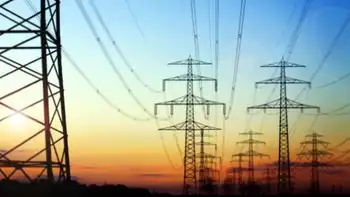Variable-speed escalators off to a shaky start
NEW YORK, NEW YORK - The Metropolitan Transportation Authority’s experiment to introduce 35 “green” escalators in four subway stations started with a lurch. In some places, it didn’t start at all.
A repairman rode one of the escalators at Herald Square as part of the checkup on the first “green” day.
Escalators at the 34th Street-Herald Square and Roosevelt Island stations in Manhattan and the Jamaica-Van Wyck and Jamaica Center-Parsons/Archer stations in Queens were to begin operating at variable speed, as part of a pilot program to save electricity and reduce wear and tear.
According to signs posted by the authority, each escalator was equipped with an infrared motion sensor that “ ‘sees’ customers approaching and ‘tells’ the escalator to speed up.” The escalators are supposed to slow to just 15 feet per minute when no one is on them, from the normal speed of 100 feet per minute. When someone steps on, the escalators should accelerate gradually to the full speed over a few seconds.
Late in the day, officials acknowledged that only 22 of the 35 escalators at the four stations were working as intended. (There are 169 escalators in the subway system.)
Paul J. Fleuranges, a spokesman for New York City Transit, the arm of the authority that runs the subways, said that there were some technical glitches, but noted that not all of the 35 escalators had been activated to run at variable speeds, even though August 11 was the programÂ’s start date.
“It is my understanding that there are three escalators at 34th Street-Herald Square that are not working in sleep-mode feature due to warranty-related issues, and that the fourth is running in normal mode,” he wrote in an e-mail message.
At the other three stations, workers were still in the process of activating the variable-speed modes, he said, and the escalators already activated were working: 6 of 8 at the Roosevelt Island station on the F line, 2 of 5 at the Jamaica-Van Wyck station on the E line, and 6 of 10 at the Jamaica Center-Parsons/Archer terminus of the E, J and Z lines.
Although Mr. Fleuranges maintained that 8 of the 12 escalators at Herald Square were working properly, a lunchtime visit suggested that only 3 of the 12 were.
As of midday, all four of the down escalators near the entrance at 35th Street and Broadway were stopped. The four up escalators were moving, but at a constant speed. At the entrance closest to the Manhattan Mall near 32nd Street, three escalators were functioning reasonably close to what the authority intended, but one of the up escalators was stopped.
Even at the working escalators, there was some confusion. At one point, a man who was trying to go down to the subway platforms stepped on a slow-moving escalator, not realizing it was going up. As he walked down, the escalator suddenly activated, bringing him back toward the station.
He did not turn around, but instead tried to race against the escalator, toward the bottom. (Officials said the escalators have an alarm that sounds if someone tries to walk past the sensor when the escalator is going in the opposite direction, but it was not clear whether it had sounded.)
“It’s dangerous,” said one passenger, Anthony Hack, 30. “Someone’s going to walk on it thinking it’s not working and then it’s going to start.”
It was also clear that some visitors were not accustomed to escalators of any speed.
Vijaya Lakshmi, 52, who was visiting from India and is unused to escalators, was hesitant to take the first step going up. She ended up falling, and sitting as the escalator moved. A man helped her to her feet, preventing her dress from getting caught in the escalator as she approached the top.
“It’s just that she’s not used to it at all,” said her son-in-law, Parasar Kobati.
Rick O’Conor, who runs the Roosevelt Islander blog, questioned the need for the new technology. “It’s not of primary importance to have motion-activated escalators,” he said. “It’s of primary importance to have escalators that work.”
He said that all 10 escalators at the Roosevelt Island station had been out of order recently, and that his elderly mother had had to walk up the stairs. “A group of teenagers were nice enough to ask if she wanted them to carry her,” Mr. O’Conor said, adding that his mother pressed on.
Of the 10 escalators at Roosevelt Island, two had yet to be fitted with the sensors and two were shut down.
Another resident, Valentina Montecinos, 28, said, “Sure, it’s a good idea to save energy, but these escalators are never working anyway.”
Related News

Canada Faces Critical Crunch in Electrical Supply
ONTARIO - Canada, known for its vast natural resources and robust energy sector, is now confronting a significant challenge: a crunch in electrical supply. A recent report from EnergyNow.ca highlights the growing concerns over Canada’s electricity infrastructure, revealing that the country is facing a critical shortage that could impact both consumers and industries alike. This development raises pressing questions about the future of Canada’s energy landscape and its implications for the nation’s economy and environmental goals.
The Current Electrical Supply Dilemma
According to EnergyNow.ca, Canada’s electrical supply is under unprecedented strain due to several converging factors. One major issue is the rapid…




